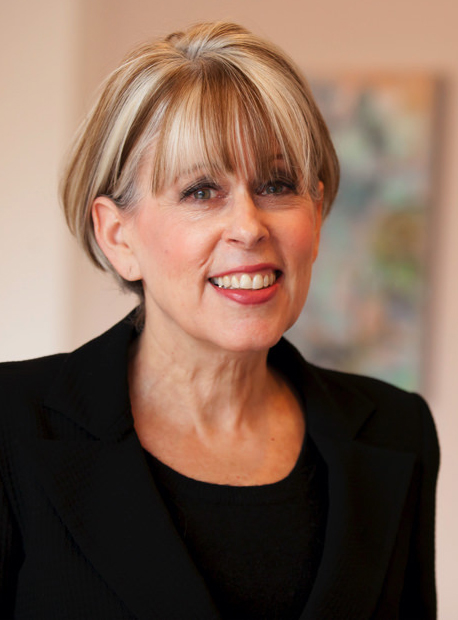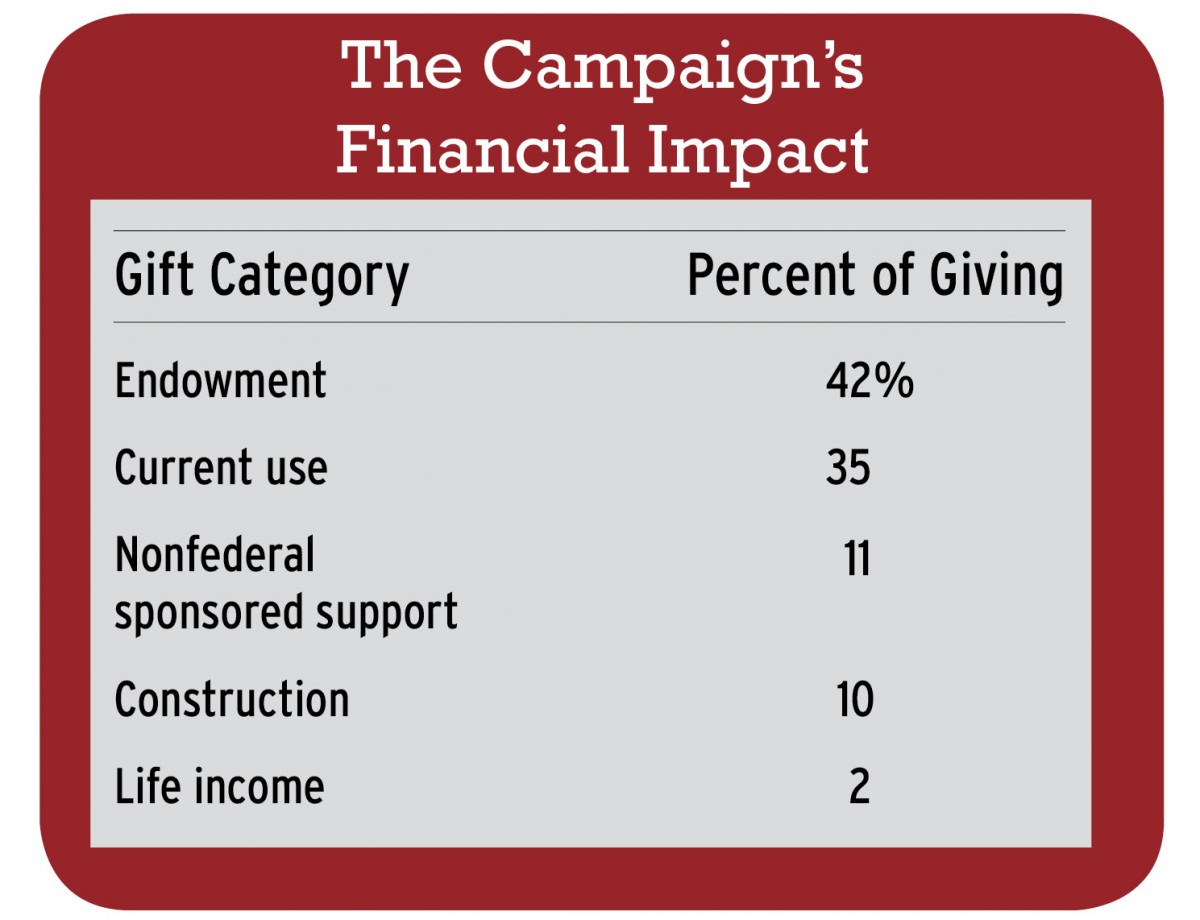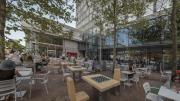The value of Harvard’s brand name has now been established: $9.62 billion. That is the sum raised during The Harvard Campaign, the University announced this morning. From the $2.8 billion of gifts and pledges received as of September 21, 2013, when President Drew Faust launched the public phase of the fundraising—toward the then-large goal of $6.5 billion—through the formal conclusion this past June 30, alumni, foundations, parents, and others worked with University development officers to sustain an annualized pace of giving of more than $1.4 billion. According to the announcement, more than 153,000 households made more than 633,000 gifts during the drive.
Lead donors were briefed on the outcome, and thanked by Faust, at a private gala on April 14 (read her remarks here). From then until today’s news, final gifts and pledges have been tallied and fully accounted for. The relatively anodyne announcement (the sum raised appears in the sixth paragraph), at the thunderously successful conclusion of a colossal campaign, is consistent with the sotto voce communications since the June 2016 disclosure that “more than $7 billion” had been committed—and perhaps also reflective of new realities:
- the tax on Harvard and other universities’ endowment investment earnings enacted last year;
- a general concern, expressed by President Lawrence S. Bacow and Harvard Corporation senior fellow William F. Lee about public dissatisfaction with higher education (and in some quarters, hostility to elite, well-endowed private institutions); and
- Bacow’s efforts to harness Harvard’s resources to address major social challenges, highlighted most recently during his visit last week to Pontiac and Detroit, Michigan, where Harvard and University of Michigan researchers will partner to work on urban poverty and the opioid epidemic.
Indeed, in the announcement, Bacow linked the philanthropy to the University’s role in benefiting society beyond the confines of the campus:
As new challenges and opportunities arise in higher education and beyond, Harvard is well positioned to respond and adapt thanks to the generosity of our alumni and friends. It is equally important that we lead by example as we seek to make the world a better place through our teaching and scholarship. We are enormously grateful to those who have supported us in this effort.
What the Campaign Has Enabled
The announcement comes as some of the tangible fruits of donors’ support become more evident. Smith Campus Center (the renovated and refashioned Holyoke Center—see photograph above) will be dedicated and officially opened this afternoon. Harvard Business School has begun using Klarman Hall, its new meeting and conference facility. Across Western Avenue, the new engineering and applied sciences center continues to take shape for occupancy in 2020 (and the faculty members and students there will pursue their work significantly supported by the landmark $400-million endowment gift for their school from John A. Paulson, M.B.A. ’80). Lowell House is a busy construction site, the latest and largest in the series of undergraduate House renewal projects. Scholars, students, and visitors have been making use of the renovated Harvard Art Museums, and the Harvard Kennedy School’s transformed facilities
New programs extend from the Harvard Teacher Fellows, preparing undergraduates to become K-12 educators, to the College concentration in theater, dance, and media—both supported by the president’s office.
Beyond alluding in a general way to the new and renovated facilities, and augmented academic programs, the announcement revealed two details about the fundraising.
- Financial-aid funds raised total $1.3 billion (13.5 percent of the campaign proceeds). If that sum were entirely in the form of endowment, it would generate about $65 million in undergraduate scholarships and graduate and professional aid and fellowships annually—an especially significant source of such funds for the Faculty of Arts and Sciences (FAS), whose aid spending has risen about $100 million per year since 2004, when the aid program was increased significantly and then further supplemented a few years later.
- Donors endowed 142 professorships, “to support current faculty and bring new scholars in a range of disciplines.” The sum required to endow a chair varies by school and level (junior versus full professorships), but this suggests that Harvard received three-quarters of a billion dollars or more for faculty positions. In notable gifts, former Microsoft executive Steve Ballmer ’77 committed to expanding the computer-science faculty, and hedge-fund manager Bill Ackman ’88, M.B.A.’92, has underwritten at least five professorships in two gifts. But at least within FAS, the principal objective was to endow existing professorships, rather than new positions. Doing so (and securing substantial endowments for scholarships, like the nine-figure gift from hedge-fund executive Kenneth C. Griffin ’89), has the effect of freeing unrestricted funds—like tuition receipts—for investments in new academic programs. That relieves pressure on FAS’s finances and creates opportunities for future deans to underwrite emerging opportunities and priorities.
In the Schools
More details about such benefits may be forthcoming from individual schools as they hold campaign celebrations to thank their supporters in coming weeks and months.
In the meantime, Harvard Medical School reports that its proceeds totaled $789.4 million (the goal was $750 million), which yielded 12 new professorships on the main campus and 57 new positions in the hospitals and other affiliated institutions. The school received 35 new endowed financial-aid funds, and has created 36 more with current-use gifts. Some 107 gifts established research funds. Overall, its endowment benefited by $324 million in gift proceeds, and current-use funds received totaled $452 million (with the remainder in life-income, construction, and loan funds).
Harvard Business School, which originally sought $1 billion, ended up attracting nearly $1.4 billion. The funds underwrote the wholesale expansion and renovation of its executive-education campus, plus substantial new facilities like Klarman Hall. Donors contributed $225 million for financial aid, which has enabled new support for first-generation students, for example, and more than one-third of a billion dollars for faculty and research, including 27 chairs for associate professors. During the campaign, the school invested in FIELD, its new experience-based curriculum that complements the traditional case-based teaching; HBX, its burgeoning online program; and its joint master’s degree with the engineering and applied sciences faculty (soon to be neighbors). In line with University experience (see below), the business school’s support was directed to endowment (45 percent), current use (38 percent), and its significant capital projects (13 percent), with the remainder to be determined or as yet undesignated.
The View from the Helm
In a valedictory conversation Tuesday about her team’s record-setting work on Harvard’s behalf, Tamara Elliott Rogers ’74, who is retiring from her position as vice president for alumni affairs and development at year-end, cited several dimensions of the campaign’s outcome. “Obviously,” she said, “we had a very successful campaign,” not only in the aggregate but in that each school exceeded its goal and therefore strengthened itself academically.

Tamara Elliott Rogers
Photograph by Rose Lincoln/HPAC
From her unique perspective of being ultimately responsible for raising about $30 million per week for several years, Rogers knows about the networks and teamwork required, and said, “We engaged many volunteers” on several dozen committees: for each school, and for focal objectives (like financial aid, funding for scientific research, and so on). Equally important, she continued, “At the end of the campaign, they are still engaged. They felt good about their efforts, they felt good about the leadership,” and about the projects and initiatives their work enabled, and the people they met during the course of the fundraising. “That is also capital,” she emphasized, “human capital and good will.” That doesn’t mean people have the immediate capacity to continue giving at the same level—but it does mean that working relationships established during the campaign are in place, and in a good place, for future efforts on Harvard’s behalf.
Among those relationships, she pointed to the effort to have cochairs for schools’ campaigns who were not previously affiliated through their degrees: people who want to raise support for the Graduate School of Education, for example, because they care about its work and mission, even though their personal ties are to other parts of Harvard. “It felt natural as people followed their interests in a very ‘One Harvard’ way,” Rogers said—and it paid off.
Finally, unlike earlier campaigns, this one combined fundraising efforts by all Harvard schools at once, which contributed to the overall synergies. And although every one of those 633,000-plus gifts counted (including her own), she said, during The Harvard Campaign, the institution was able to cross the threshold to very large gifts, in a way the prior $2.65-billion University Campaign, concluded at the end of 1999, did not. Along with the Paulson and Griffin gifts, the Chan family’s $350-million endowment gift for public health ranked as a transformative moment for that resource-constrained school.
Looking ahead, Rogers said, there will no doubt be further philanthropy to come, “especially at a place like Harvard where we have such an astounding alumni base.” It will be up to President Bacow to determine the next priorities, of course, but she was not giving away any secrets when she said the institution would always seek more funding for financial aid in every school (her own particular passion, given her past experience in undergraduate admissions)—and for further investments in innovative learning and teaching practices (“a core part of our mission,”); to complete House renewal; and to propel advances in scientific research while sustaining Harvard’s strengths in the humanities and the arts.
But any campaign has a limited life, Rogers reflected, a good thing—and this one having run its course, she can now, with satisfaction, begin reclaiming some of her life.
An Existential Fiscal Impact
The campaign’s aggregate impact can also be viewed in strictly financial terms—in which perspective, its effects loom especially large.
When it was announced in the fall of 2013, the value of Harvard’s endowment had recovered to $32.7 billion—a sum that was still $4 billion less than at the end of fiscal year 2008, before the financial crisis. In the meantime, pressing needs—to maintain aging campus facilities, for example, and pay for the very large expansions of undergraduate (and other) aid implemented in 2004 and late 2007 (just before the financial crisis reduced the endowment by $11 billion, and the recession increased families’ need for scholarship support)—became ever more pressing.

According to figures provided by the University, more than 40 percent of the campaign gifts and pledges are for endowment: about $4 billion when fully received. That sum is more than 10 percent of the $37.1 billion value of the endowment reported for the fiscal year ended June 20, 2017 (2018 results will likely be reported in early autumn). Given the University’s reliance on endowment distributions for 36 percent of its total operating revenues (and much greater dependency for the Faculty of Arts and Sciences and some other schools), having that permanent capital is critically important for sustaining Harvard’s academic mission.
From fiscal 2012 through fiscal 2017, endowment gifts received and accounted for in Harvard’s financial statements—largely attributable to the campaign’s quiet and public phases—totaled more than $2.3 billion. As a thought exercise, subtracting that sum from the endowment’s June 30, 2017, value of $37.1 billion leaves $34.8 billion (a value that is overstated because it ignores investment returns on the sums received during intervening years). In real terms, adjusting for inflation, that sum would have to be reduced by an additional $6 billion or so (as explained here), to perhaps $29 billion: not far from the financial-crisis low points of $26.1 billion in fiscal 2009 and $27.6 billion in fiscal 2010. In the meantime the University’s annual spending has increased about 35 percent since then: $1.3 billion per year. But for the campaign’s largess, the pressure on the endowment would be enormous; Harvard could not conceivably sustain operations on its current scale absent the campaign’s boost to permanent capital (endowment gifts) and current-use giving.
Current-use funds—the president’s and deans’ principal way of directing investments into new programs, equipping the laboratories of newly hired professors, and more—accounted for 35 percent of the campaign proceeds. No doubt much of that cash has already been used, and a majority of it is accompanied by at least some restrictions on those uses, but some funds have surely been reserved for future contingencies—and professors’ breakthrough ideas. Of late, current-use giving has approached a half-billion dollars annually, nearly twice the pre-campaign total, and has accounted for 9 percent of operating revenues, up a couple of percentage points from the beginning of the decade.
The campaign also counted funding for research projects received from nonfederal sources (foundations, individuals, corporations, and others)—about 11 percent of the total raised, and presumably largely spent relatively quickly. Another 10 percent of campaign proceeds was earmarked for construction projects—among them, the prominent ones listed above; those funds, too, have presumably already been put to work, or will be soon, keeping Boston construction crews busy. Finally, life-income funds account for about 2 percent of gifts: trust or annuity agreements that provide specified benefits to the donors with principal proceeds pledged to Harvard uses in the long term.
Together, those sums added up to that $9.62 billion in gifts and pledges—at a time Harvard urgently needed the support its friends have so generously bestowed.
Read the University announcement here.









